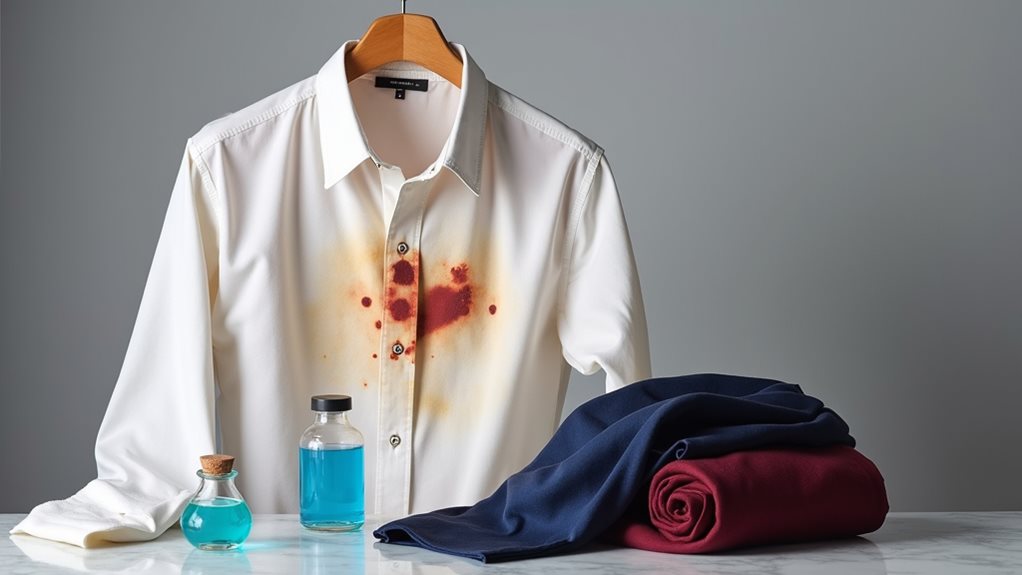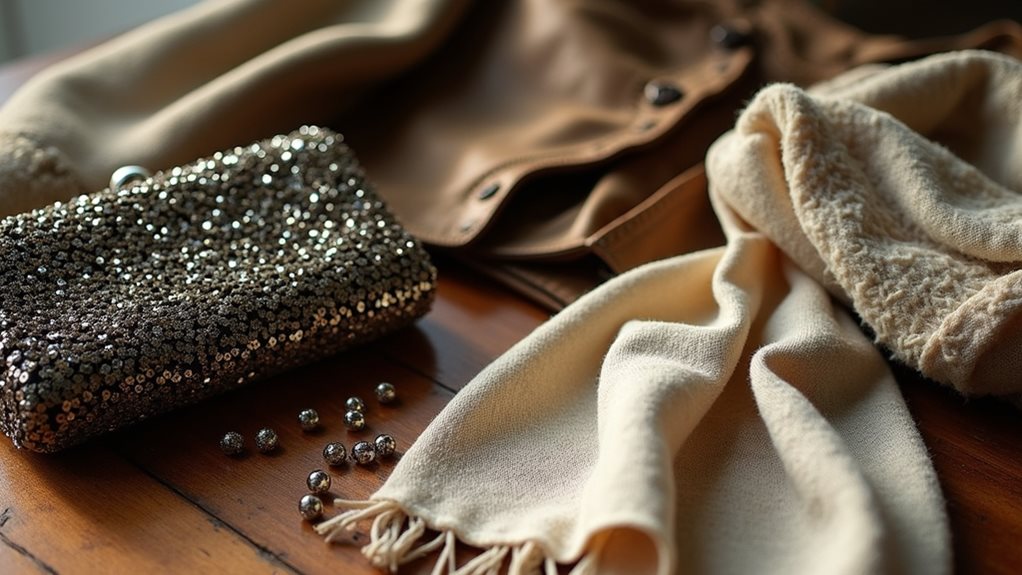Your dry cleaning timeline depends entirely on what you’re dropping off, and honestly, I’ve learned this the hard way after countless last-minute wardrobe emergencies. Basic items like dress shirts typically take 1-2 days, while formal suits need 3-5 days, and specialized pieces like wedding dresses can require up to three weeks. Peak seasons, complex garment requirements, and staff limitations can extend these timeframes considerably, so understanding these factors will help you plan ahead more effectively.
Understanding the Dry Cleaning Process and Timeline Factors
When I first started using dry cleaning services, I’ll admit I was completely clueless about how long the whole process would actually take, and I learned the hard way that dropping off a suit the day before an important meeting wasn’t exactly my brightest moment 😅.
Dropping off my suit the day before an important meeting definitely wasn’t my brightest planning moment.
The dry cleaning process involves five crucial steps that directly impact turnaround time: drop-off, inspection, cleaning, pressing, and quality control.
Standard items typically need 1-2 days, while delicate garments require 3-4 days or longer depending on their complexity.
Specialized dry cleaning for items like a wedding dress can take weeks, especially when dealing with stubborn stains.
Various factors that can extend cleaning times include holiday rushes, garment condition, and staff limitations, so always check with your local dry cleaners for accurate estimates.
If you need your garments quickly, many establishments offer same-day service for an additional fee, though this typically depends on the cleaner’s current workload and the complexity of your items.
Turnaround Times for Different Types of Garments

Different garments require vastly different amounts of time at the dry cleaner, and I’ve learned this lesson through countless wardrobe emergencies that could’ve been avoided with better planning 🤦♀️.
Standard clothing items like dress shirts and trousers typically have a turnaround time of just one to two days, making them your safest bet for last-minute cleaning needs.
However, delicate garments with intricate designs demand special care, often requiring three to four days or more during the dry cleaning process.
I’ll never forget rushing my wedding dress to the cleaner just days before my ceremony, only to discover it needed two weeks for proper preservation.
Formal suits generally take three to five days, while large items like comforters can stretch your cleaning needs to a full week.
For urgent situations, many cleaners offer same-day service for an additional fee, though this expedited option may not work for all fabric types or complex stain removal needs.
Specialized Items That Require Extended Processing

When you bring your most precious garments to the dry cleaner, you’ll discover that some items simply can’t be rushed through the standard process, much like how my grandmother always said the best things in life require patience and care.
Your wedding dress, for instance, demands the kind of meticulous attention that transforms a simple cleaning into an art form, often requiring anywhere from three days to two weeks depending on those intricate beadwork details and delicate silk layers that make your gown so breathtakingly special.
Similarly, your favorite leather jacket or those luxurious suede boots you splurged on last winter need their own timeline of five to seven days, because rushing these materials through regular cleaning would be like trying to hurry a soufflé – you’ll end up with disappointing results that nobody wants to see. 😅
Beyond fabric type, stain severity plays a crucial role in determining processing time, as heavily soiled garments require special treatments that can extend the cleaning timeline well beyond the standard 2-3 business days.
Wedding Dress Processing
Most wedding dresses represent thousands of dollars and countless memories, which explains why they demand the most careful, time-intensive cleaning process in the dry cleaning world.
Your wedding dress isn’t just another garment—it’s a masterpiece of delicate fabrics, intricate designs, and precious embellishments that require specialized techniques for proper care.
The cleaning process typically takes anywhere from one to three weeks, depending on the complexity of stains and preservation requirements.
Makeup smudges, wine spills, and dirt from outdoor ceremonies often need additional treatment time to guarantee complete removal without damaging those gorgeous beadwork details.
When selecting a cleaning service, it’s essential to choose experienced cleaners who specialize in wedding gowns, as improper handling can irreversibly damage these irreplaceable garments.
Don’t forget the preservation process adds extra days to your turnaround time, but trust me, protecting your gown’s legacy is absolutely worth the wait!
Leather and Suede
While wedding dresses capture our hearts with their elegance, leather and suede garments present an entirely different challenge that’ll test your patience in ways you never expected.
These delicate materials demand specialized cleaning methods that extend processing time to 5-7 days, unlike your typical Tuesday shirt drop-off 😅.
Your favorite leather jacket can’t handle standard dry cleaning solvents—it needs specific care requirements that differ completely from traditional methods.
Suede requires even more attention, with careful inspection to preserve that soft texture you love.
Stains? Well, they’re particularly stubborn on these materials, often requiring additional treatments that’ll push your turnaround time even further.
Always label these items clearly when dropping them off, guaranteeing they receive the specialized attention they desperately need.
Leather goods are among the everyday items that often require professional dry cleaning to preserve their quality and appearance over time.
Factors That Can Extend Your Dry Cleaning Wait Time

While most dry cleaning runs effortlessly, you’ll occasionally hit those frustrating bumps that stretch your pickup date beyond what you’d planned.
Trust me, I’ve learned this lesson the hard way when I needed my suit cleaned right before a wedding 😅.
High volume periods, like the weeks before major holidays or during local festival season, can turn your usual two-day turnaround into a week-long wait as cleaners juggle mountains of formal wear and special occasion outfits.
Complex garment requirements also throw a wrench into timing, because that intricate beaded dress or heavily stained jacket demands the kind of careful attention that simply can’t be rushed, no matter how much you might wish otherwise.
Specialty items like wedding dresses or leather goods may require 5-7 days or longer due to the specialized cleaning processes they require.
High Volume Periods
When your local dry cleaner suddenly transforms into what feels like the busiest subway station during rush hour, you’ll quickly realize that timing can make or break your dry cleaning experience.
High volume periods during holidays, weddings, and prom season create longer processing times that’ll test your patience.
Peak seasons bring delicate garments requiring intricate cleaning processes, while extremely soiled clothing demands additional treatments that stretch resources thin.
Staff limitations from vacations or unexpected absences slow turnaround time considerably, especially when you’re dropping off that “must-have” outfit for tomorrow’s event 😅.
During these busy periods, even same day service may become unavailable or require earlier drop-off times than usual.
My advice? Plan ahead during busy periods, because your dry cleaner’s working overtime to handle the chaos, and rushing rarely leads to the quality results you’re paying for.
Complex Garment Requirements
Because your grandmother’s vintage beaded gown isn’t just another piece of clothing walking through the door, it demands the kind of meticulous attention that transforms a simple cleaning into an art form.
Complex garments like formal dresses with intricate designs require specialized handling that can extend your turnaround time from days to a full week or more.
When you’re dealing with delicate fabrics such as silk or heavily embellished pieces, your cleaner must employ specialized cleaning methods that involve additional care throughout every step of the cleaning process.
Professional dry cleaners use chemical solvents instead of water to preserve the fabric’s texture, color, and shape while effectively removing oils and stains that traditional washing cannot handle.
If your garment needs repairs or alterations after cleaning, you’re looking at even more time, since these services require their own careful timeline to complete properly.
Home Dry Cleaning Time Estimates and Effectiveness

How quickly can you actually get your clothes clean using those at-home dry cleaning kits you see at the grocery store?
Well, I’ve tried them myself, and while they’re convenient, the cleaning time is surprisingly short compared to professional services.
The overall process typically takes 30 minutes to an hour, but here’s what you’re looking at:
- Pre-treating visible stains takes just a few minutes of your attention
- Loading garments into the special cleaning bag happens in minutes
- Tumble drying activates cleaning agents and requires 30-60 minutes
- Letting clothes sit afterward allows remaining chemicals to dissipate properly
Results rarely match professional dry cleaning effectiveness, unfortunately.
Though home dry cleaning kits offer quick stain removal and faster cleaning time than professional services, they’re honestly more of a temporary solution than a replacement.
These kits work best on lightly soiled items and can help refresh clothes between professional cleanings, but they struggle with heavily stained garments and delicate fabrics.
Items That Cannot Be Processed Through Dry Cleaning

Why would a dry cleaner turn away your favorite leather jacket or that gorgeous beaded dress you splurged on last year? Understanding items that can’t be processed through standard dry cleaning takes some insider knowledge, and honestly, I learned this the hard way after ruining a vintage suede skirt 😅.
Fur garments are absolute no-gos since solvents strip their natural oils, leaving them looking like roadkill. Leather requires specialized treatments that differ completely from typical cleaning methods.
Delicate fabrics like certain silks and chiffon can disintegrate faster than your weekend plans, while heavy beading and intricate embellishments become casualties of the tumbling process.
Additionally, everyday cotton items like t-shirts and jeans are unnecessarily expensive to dry clean and can lose their intended feel and performance properties in the process.
When dry cleaning takes a turn for disaster, these items need alternative care methods.
Proper Storage Methods for Your Cleaned Garments

After investing time and money in professional dry cleaning, you’d think the hard work ends when you pick up your freshly cleaned clothes.
But honestly, that’s where many people make their biggest mistake. Most dry cleaners hold your garments in plastic covers, which you’ll want to remove immediately since proper storage requires breathable solutions that protect against moisture and dust.
Plastic covers from dry cleaners trap moisture and damage your garments – switch to breathable storage immediately after pickup.
Here’s how to keep your cleaned garments looking pristine:
- Use breathable garment bags instead of plastic covers for long-term storage
- Hang everything on padded hangers to maintain shape and prevent stretching
- Store in cool, dry spaces away from direct sunlight to prevent fading
- Regularly check stored garments for pest damage or deterioration signs
- Avoid basements or attics where humidity fluctuates dramatically
Your future self will thank you! 😊




